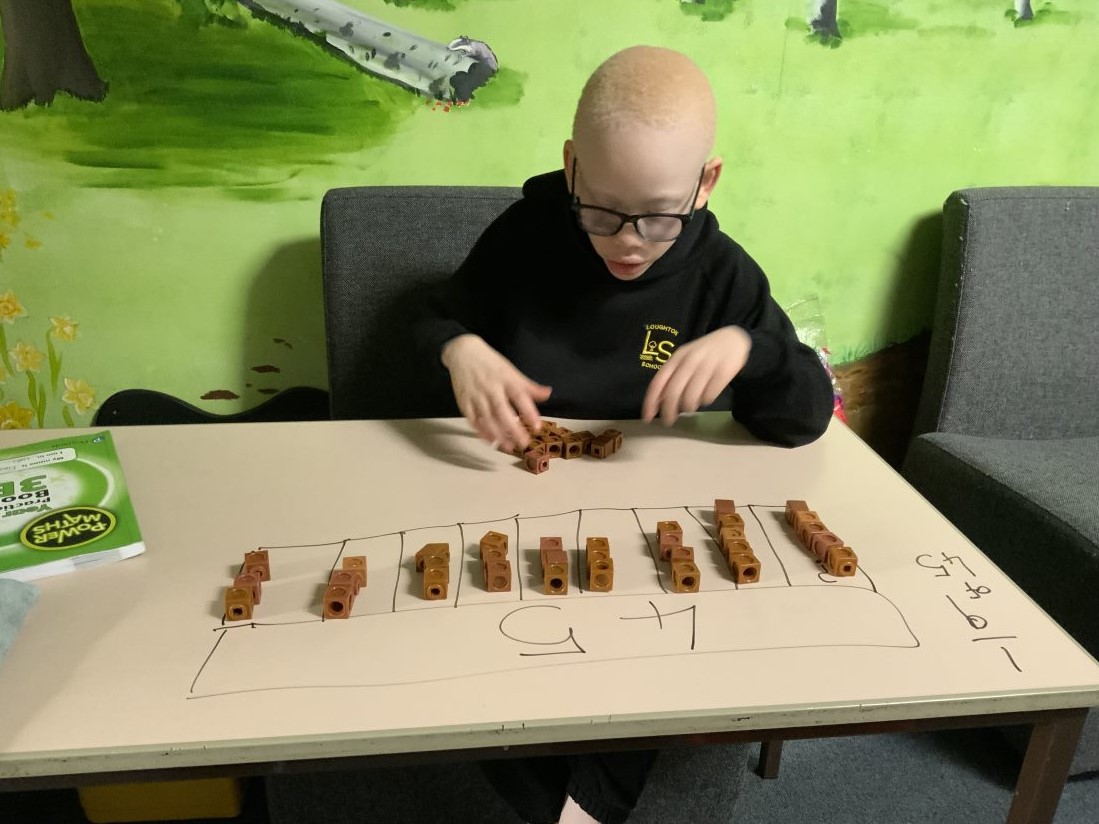Maths
Our maths subject leader is Mrs Charlie McNeaney who is supported by Mrs Lizzie Woodards and Mrs Cathy Higgins.
‘We believe that every child can achieve in mathematics. We want every child to leave Loughton school enjoying maths, developing a set of mathematical skills that they can build upon in their future education.’
We use Power Maths as a coherent tool to allow children to revisit prior learning, build upon knowledge and ensure every child has a deep understanding within each mathematical concept. To be able to achieve this, we use the Power Maths yearly and termly overviews, which break the curriculum into core concepts for each year group, taught in units. A unit is divided into smaller learning steps – lessons. Step by step, strong foundations of cumulative knowledge and understanding are built.
Throughout the year, the children will continue to build upon concepts they have learnt. For example, addition and subtraction is taught in the autumn term in year 3, built upon in the spring term within their money, statistics and length unit and then progressed to in the year 4 National Curriculum outcomes in the autumn term of year 4. Teachers and children make links to prior learning, which is made explicit on their working walls; via discussions and within the beginning of their planning units.
Lessons are designed to expose the underlying mathematical structure behind concepts. Children use stem sentences within most lessons to expose the core concepts. This supports children’s ability to build upon prior knowledge by recalling stem sentences from the lessons and retrieving prior knowledge when revisiting learning. The children use their knowledge found in lessons to justify and reason using precise mathematical language modelled by teachers.
Delivery of a Power maths lesson at Loughton school
Each lesson will include a range of explanation, modelling, scaffolding and practice as outlined below.
Power up:
- Retrieval activity, which supports the fluency of key number facts and checks on retention of prior knowledge.
- Each unit begins with a check on pre-requisite skills, supported by the DfE document, ‘Teaching mathematics in primary schools (2020)’.
Discover:
- Instead of ‘Let me teach you…’, children are encouraged to explore a real-life problem themselves to see what they already know, explore language and discuss possible approaches or representations that can be used.
Share (teacher modelling):
- The teacher will organise findings from the discover activity, comparing and contrasting methods and guiding them towards efficiency for the approach being taught in the lesson.
- Teachers will model methods using key representations, built upon throughout their maths journey to expose underlying mathematical structures.
Think together (scaffolding and practice):
- During this stage, the children will work in pairs to practise the concept being taught in a scaffolded, supportive manner.
- Mixed-ability seating here is crucial, to allow precise mathematical language to be used to explain and justify methods with one another.
Practice:
- All children independently practise the concept that has been taught in their practice books.
Reflect:
- Unpicks misconceptions and draws the learning together, clarifying succinctly their findings for the day.
Personalisation (scaffolding):
- Children deepen their learning in lessons through the use of rich and sophisticated problems, carefully planned questioning and variation within activities that make children stop and think flexibly about concepts.
- To strengthen children’s understanding, teachers use a range of practical resources, carefully planned questioning and representations to allow children to see the maths structure along with adult support.
Formative assessments include the use of planned assessment questions supported by the teacher guides and a RAGing system where the LSA and Teacher collaborate to identify children who are not understanding the concept being taught. RAG sheets are completed at the end of the lesson to inform interventions.
Retrieval questions, which include prior concepts that have been taught are planned so that teachers can identify whether their children have retained knowledge/understanding weeks or months after it was last taught. Teachers then make notes on the RAGing sheets of concepts and children who have not retained the knowledge to support for interventions. Teachers will pay particular attention to the fluency of children’s number facts and understanding.
Interventions are delivered on the same day where possible. Over the years, this has become more flexible to also include teacher’s tuition times, carefully planned homework to targets gaps and in lesson reviews.
Summative assessments are completed half-termly to identify children’s retention and understanding of concepts. Test results are then uploaded to Active Learn where a gap analysis is provided for the whole class and individual pupils. From this, targets are designed to adapt fluency within lessons to review knowledge, individual children are discussed in pupil progress meetings alongside the maths subject leader and communications of targets are reported to parents during parents’ evenings and school reports.

KS2 attainment in Mathematics

Key stage 2 attainment: National Headlines:
Please select a link below for subject booklets and useful information:
- The Essence of Teaching For Maths Mastery
- Fluency Websites for Parents
- TT Rockstars and Numbots
- Mindset in maths - an introduction
- The Power Maths characters
- Loughton School's calculation policy
Understanding Written Methods of Calculations
At Loughton School, we believe every child is a mathematician. The National Curriculum requires children to master the skills of mental calculation as well as efficient written methods (+, -, x, ÷). These are essential tools for effective problem solving, reasoning and mathematical explanation. In order for parents to support their children’s learning, the short videos below explain how we teach written methods. We start with expanded methods so that the children understand the mathematical structure. Eventually, when they are confident we move the children on to the shorter, more traditional methods. Written methods are taught alongside a growing awareness of and confidence using place value and the number system.
Have a look at the 'how to' formal method videos for:
Year 4 multiplication tables check:
What is the multiplication tables check?
The multiplication tables check (MTC) is statutory for all year 4 pupils registered at state-funded maintained schools, special schools or academies (including free schools) in England.
The purpose of the MTC is to determine whether pupils can recall their times tables fluently, which is essential for future success in mathematics. It will help schools to identify pupils who have not yet mastered their times tables, so that additional support can be provided. (DfE, 2024)
What can you do at home?
To support the learning of times tables, we have a school subscription to Times Tables Rock Stars (TTRS). Please ask your child to check with their class teacher if they are unsure of their log in details. More information for parents can be found here.
Loughton School's Multiplication Tabes Check results:

*Official statistics for 2023/2024
Please see this link for more information about the end of year 4 multiplication tables check.
